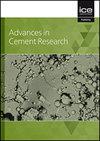添加葡萄糖酸钠的硅酸盐水泥浆水化过程中的声学特性
IF 1.3
4区 工程技术
Q3 CONSTRUCTION & BUILDING TECHNOLOGY
引用次数: 0
摘要
采用自制压电换能器,对添加葡萄糖酸钠(SG)的硅酸盐水泥浆体的水化行为进行了超声沥青捕捉实验研究。x射线衍射(XRD)分析表明,Ca(OH) 2的衍射峰强度随SG含量的增加而减弱,特别是当SG含量大于0.1wt.%时。SG含量大于0.05wt时硬化水泥浆体的抗压强度。%显著下降。水化龄期2 h出现超声波形,SG含量为0.15wt的水泥浆体波形幅值。%和0.2wt。%明显大于SG含量为0.05wt的样品。%在水化初期。根据头波振幅变化,将300 h水泥浆体水化过程分为三个阶段,即波动变化期、快速增长期和平稳增长期。在水化龄期为48 h之前,水化声传播时间随水化变化较大,说明水泥浆体的水化硬化过程在48 h内较为剧烈。本文提出的超声监测方法为添加葡萄糖酸钠的水泥浆体水化行为研究开辟了新的视角。本文章由计算机程序翻译,如有差异,请以英文原文为准。
Acoustic behavior of Portland cement paste with additive of sodium gluconate during hydration
The ultrasonic pitch-catch experiment was conducted to study the hydration behavior of Portland cement paste with additive of sodium gluconate (SG) by using the tailor-made piezoelectric transducer. The X-ray diffraction (XRD) analysis shows that the intensity of the diffraction peak of Ca(OH) 2 decreases with increasing the SG content, especially when the SG content is larger than 0.1wt.%. The compressive strength of the hardening cement paste when SG content is larger than 0.05wt.% decreases remarkably. The ultrasonic waveforms appear at hydration age of 2 h, and amplitudes of waveform of the cement pastes with SG contents of 0.15wt.% and 0.2wt.% are obviously larger than those with SG content of 0.05wt.% in the early hydration stage. The hydration process of cement paste in 300 h can be classified into three stages based on the head wave amplitude variation, that is, the fluctuation variation period, the rapid increasing period and smooth increasing period. The acoustic propagation time changes greatly with hydration before hydration age of 48 h, indicating that the hydration and hardening process of the cement paste is violent in 48 h. The proposed ultrasonic monitoring method opens a new perspective for hydration behavior study of the cement paste with additive of sodium gluconate.
求助全文
通过发布文献求助,成功后即可免费获取论文全文。
去求助
来源期刊

Advances in Cement Research
工程技术-材料科学:综合
CiteScore
3.70
自引率
5.00%
发文量
56
审稿时长
3.2 months
期刊介绍:
Advances in Cement Research highlights the scientific ideas and innovations within the cutting-edge cement manufacture industry. It is a global journal with a scope encompassing cement manufacture and materials, properties and durability of cementitious materials and systems, hydration, interaction of cement with other materials, analysis and testing, special cements and applications.
 求助内容:
求助内容: 应助结果提醒方式:
应助结果提醒方式:


